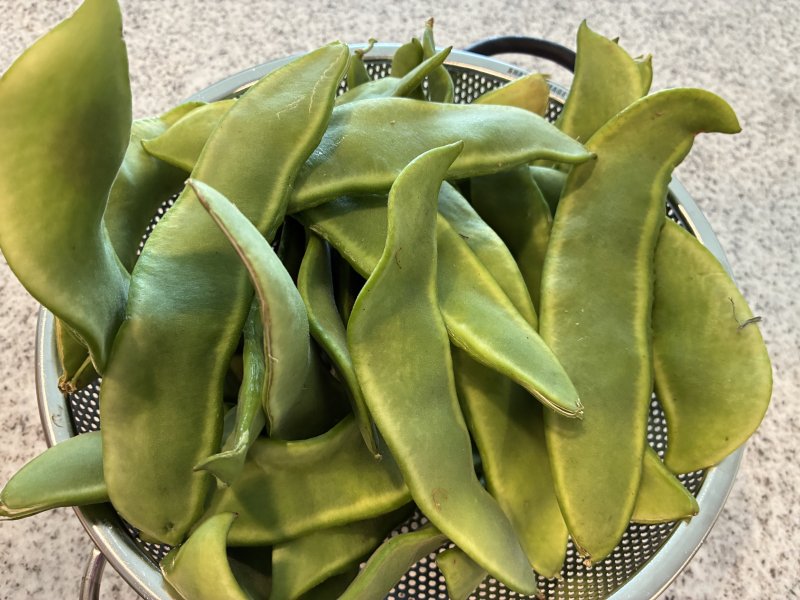Lima beans are in season, so enjoy them fresh!
Last week I purchased a quart of pole bean limas, still encased in their gnarly pods (see photo). The woman at the register demonstrated how to remove the beans from their shell, by finding the stem end and pulling it along the edge to open the pod. Once you have access to the interior, simply pop out the beans. Each pod held between three and five pale-green lima beans, each roughly the size of a quarter.
Lima beans are native to Peru, where they have been cultivated for over 9,000 years. The horticultural name, phaseolus lunatus, refers to their half-moon shape. This nutritious bean, a staple food of the Incas, was brought to Europe by traders and spread from there to the rest of the world, where it remains a common side dish, usually served steamed or boiled.
These larger lima beans are not the same variety as those called “baby limas.” The term baby refers to their smaller size, not a reference to being younger or immature. The larger lima beans hold their shape well when cooked, making them a good choice for stews or soups. Baby limas can disintegrate if cooked too long, so they’re best quickly steamed.
Another naming convention, typically seen in the southern United States, is “butter beans.” These are the same thing as lima beans, but typically sold in dried form, rather than fresh or frozen. They are yellowish-beige in color, instead of pale green. Because they are dried, the cooking process is usually a long, low and slow simmer, typically seasoned with ham hocks.
An important note about lima beans is that they contain a compound called linamarin that converts into poisonous cyanide when the bean is chewed raw. Although lima beans grown in the United State are regulated to ensure there are only trace amounts of this toxin, it is essential to cook lima beans before eating them.
Like so many beans, limas are an excellent source of plant-based protein, dietary fiber and iron. And, they’re creamy in texture with a delicate flavor. An easy way to prepare lima beans (removed from their shell) is to place them in a skillet with just enough water to cover them and cook for about 20 minutes (less time for baby limas). Season with salt and pepper, and toss with some butter for a simple side.
One of the most popular dishes to feature lima beans is called succotash. The name comes from the Native American tribe known as the Narragansett, from what is now Rhode Island. Their word “msickquatash” translates as “broken corn,” which describes the mixture of lima beans and corn kernels we enjoy today. However, there is a great deal of debate about the recipe for succotash.
If you refer to an older cookbook, such as Fannie Farmer from the early 1900s, there are only two main ingredients: lima beans and corn. By the time “Joy of Cooking” reissued its 75th anniversary edition in 2000, the recipe was still fairly simple, adding just butter, thyme and paprika. When you go forward in time, you find all sorts of other items added to the mixture, ranging from okra to bell pepper to bacon bits and rice.
Like so many basic dishes, if you begin with absolutely fresh ingredients, you don’t need to add very much. Sometimes, giving the flavors a chance to shine on their own is a better alternative than creating confusion with all sorts of unnecessary extras. I’ve included a recipe for simple succotash, as well a dish from Bob's Red Mill that uses frozen limas and throws in a few extras. Enjoy fresh limas while they’re in season!
Succotash
Rinse and drain the lima beans. Place in a pan with water to cover. Simmer over medium heat until tender, about 20 minutes; drain any remaining water and add butter. Shuck corn and cut kernels off the cobs. Add corn kernels to lima beans; stir to combine. Season to taste with salt and pepper. Yield: 4 servings.
Succotash & Quinoa Salad*
Bring 2 C broth to a boil in a 2-quart pot. Stir in quinoa. Cover, reduce heat to medium and simmer until the broth is absorbed, about 12 minutes. Remove from heat and let stand for 15 minutes. Place lima beans and 2 C broth in a large skillet. Bring to a boil, lower heat and simmer until just tender, about 20 minutes. Add shallot and garlic to the skillet with beans. Cook until shallot is tender, about 5 minutes. Stir in corn and pepper; cook until corn is crisp-tender, about 5 minutes. Add tomatoes and cooked quinoa, tossing to combine. Season to taste with salt and pepper. Serve warm or at room temperature. Yield: 4 to 6 servings. *Adapted from Bob’s Red Mill.























































